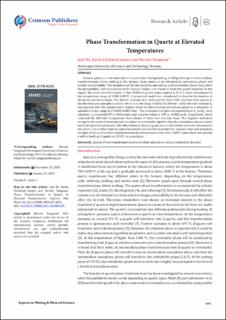| dc.contributor.author | He, Jiali | |
| dc.contributor.author | Jusnes, Karin Fjeldstad | |
| dc.contributor.author | Tangstad, Merete | |
| dc.date.accessioned | 2021-02-19T14:44:26Z | |
| dc.date.available | 2021-02-19T14:44:26Z | |
| dc.date.created | 2021-01-15T21:44:25Z | |
| dc.date.issued | 2021 | |
| dc.identifier.citation | Aspects in Mining & Mineral Science (AMMS). 2021, 691-699. | en_US |
| dc.identifier.issn | 2578-0255 | |
| dc.identifier.uri | https://hdl.handle.net/11250/2729313 | |
| dc.description.abstract | Natural quartz is a raw material in Si production. During heating, it will go through a series of phase transformations before melting in the furnace, from quartz to an intermediate amorphous phase and further to cristobalite. The formation of the intermediate amorphous and cristobalite phases may affect the permeability and reaction rate in the furnace. Hence, it is crucial to know the quartz behavior. In this regard, the phase transformations in four different quartz types, named A, D, F, G, were investigated in the temperature range of 1500-1650 oC. A numerical model was introduced to describe the kinetics of the phase transformations. The kinetic constant of k1 indicated the first-order reaction from quartz to the intermediate amorphous phase, which is in the range of 0.012-0.168 min-1; while the rate constant k2 corresponds with the second-order reaction from the intermediate amorphous phase to cristobalite, is calculated in the range of 0.00036-0.0097 min-1. The activation energies corresponding to k1 and k2 were calculated as positive(199 to 364 kJ/mol) and negative values (-108 to -448 kJ/mol), respectively, which indicated the different temperature dependence of these two reaction steps. The negative activation energy in the reaction from amorphous phase to cristobalite signifies that the amorphous phase is more stable at higher temperatures. The effect of impurities and grain size on the kinetics were also discussed in the article. It is verified that the numerical model was reliable to predict the reaction rates and activation energies in the quartz phase transformation at a temperature lower than 1600°C since there was already a soften/melting of quartz at 1650°C in some types. | en_US |
| dc.language.iso | eng | en_US |
| dc.publisher | Crimson Publishing | en_US |
| dc.rights | Navngivelse 4.0 Internasjonal | * |
| dc.rights.uri | http://creativecommons.org/licenses/by/4.0/deed.no | * |
| dc.title | Phase transformation in quartz at elevated temperatures | en_US |
| dc.type | Peer reviewed | en_US |
| dc.type | Journal article | en_US |
| dc.description.version | publishedVersion | en_US |
| dc.source.pagenumber | 691-699 | en_US |
| dc.source.journal | Aspects in Mining & Mineral Science (AMMS) | en_US |
| dc.identifier.doi | 10.31031/AMMS.2021.06.000629 | |
| dc.identifier.cristin | 1872440 | |
| dc.relation.project | Norges forskningsråd: 256788 | en_US |
| cristin.ispublished | true | |
| cristin.fulltext | postprint | |
| cristin.fulltext | original | |

